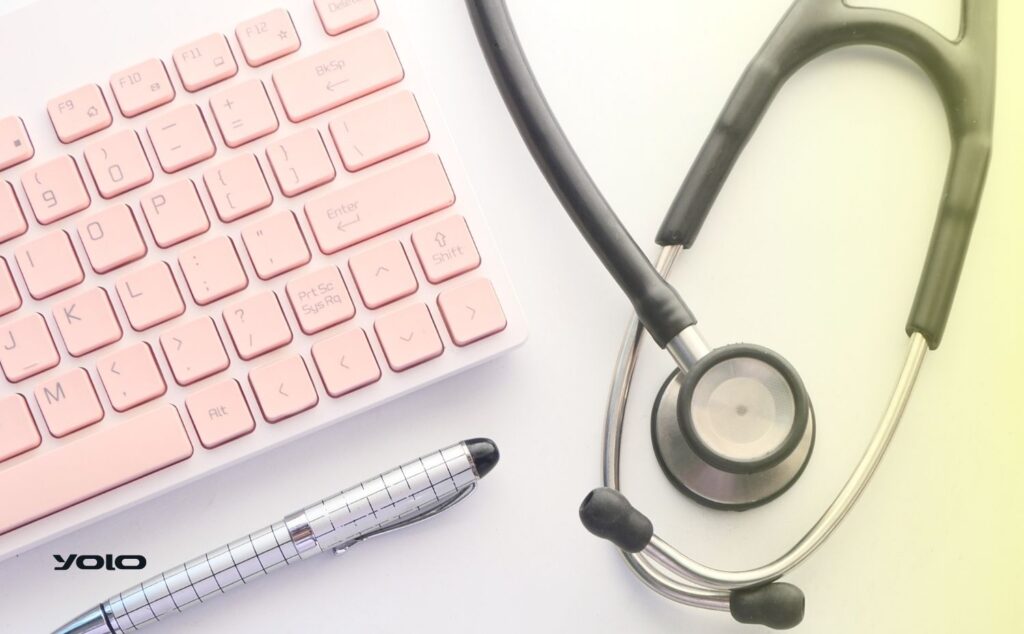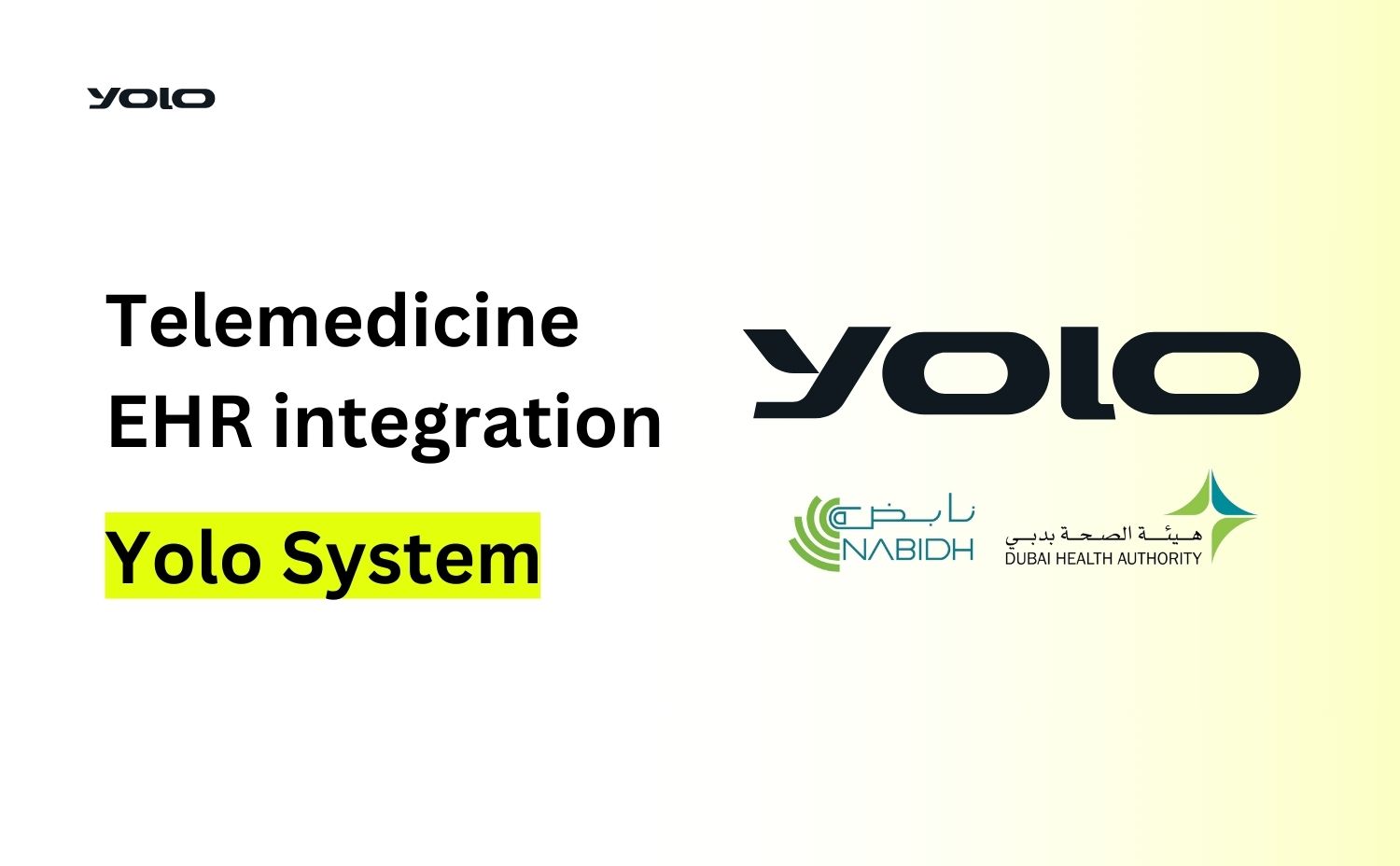When people hear EHR integration and telemedicine in the same sentence = Telemedicine EHR Integration, they feel this expression sounds more technical than helpful. But, in real clinics, it’s less about fancy systems and more about making daily tasks easier.
How do real clinics actually use EHR with telemedicine?
It usually starts with a simple goal which is keeping everything in one place…
- A patient books a virtual visit through an online portal, and the appointment automatically pops up in the clinic’s schedule.
- When the doctor starts the video call, they instantly have the patient’s medical history on the screen, along with options to take notes, update records, or send prescriptions, all without switching programs.
- After the call, the notes are saved directly in the patient’s file, and any follow-up tasks (like sending a lab order or scheduling the next visit) are just a click away.
For example, at Yolo, the EHR is already built into the telemedicine platform. That means once a consultation ends, the summary, prescription, and invoice are already saved to the patient’s file, AND the doctor doesn’t need to re-type anything later, also the admin team doesn’t have to chase down loose ends.
Do I need a separate system for telemedicine and EHR, or can they work together?
No, you don’t need two separate systems. In fact, it’s usually better if your telemedicine tools and your electronic health records (EHR) system work together in one place.
Because it makes things easier. To illustrate: Imagine you’re conducting a virtual appointment. You’d certainly want to see the patient’s medical history directly on screen, take notes, maybe send a prescription, and have it all automatically saved to their file.
But if you’re using two different systems that don’t communicate, you’ll have to copy and paste, switch tabs, or re-enter data, which wastes time and can lead to errors.
So, unless there’s a really specific reason to keep them separate (which is rare), it usually makes sense to use a setup where everything works together.

What are the biggest problems clinics face when using Telemedicine EHR Integration?
Even when telemedicine and EHR systems are built to work together, clinics still run into a few common problems.
First off, the tech itself can be tricky.
Not every system plays nicely with others, and sometimes the software just isn’t built with real-world clinic workflows in mind. You might end up with a setup that technically integrates, but still feels clunky like having to click through a bunch of screens just to start a video call.
Training is another big one.
Even if the system works well, staff need time to get used to it. And, unfortunately, doctors and nurses are already overburdened, and requiring them to learn a new user interface – especially under pressure – can slow things down and cause frustration.
There’s also the issue of internet and hardware.
Not every clinic (or patient) has a strong, stable connection. If the video lags, cuts out, or doesn’t start at all, it throws off the whole appointment and wastes everyone’s time.
And of course, security and privacy always come up. Clinics have to make sure that patient data stays protected, especially when it’s being shared over video or stored in the cloud. That means staying on top of updates, compliance rules, and sometimes even investing in extra IT support.
In short, we can say that Telemedicine EHR Integration can work but It will take planning, using the right tools, and a bit of patience to make everything work the way it should.
Yolo System | Clinic Management System
The UAE’s Only Clinic Management System with a 24-Hour Support Guarantee – Or Your Money Back!
What does a ‘good’ Telemedicine EHR Integration look like in practice?
A good integration feels almost invisible; everything just works, without anyone having to think too hard about it… as we explained before at How do real clinics actually use EHR with telemedicine?. And, From the patient’s perspective, it’s just as simple:
- They get a link to the appointment.
- log in from their device.
- talk to the doctor without needing to download extra apps or jump through hoops.
- After the visit, they might get a summary, prescription instructions, or a message from the clinic, all through the same platform.
That means:
- No laggy video calls, no data getting lost between systems.
- no complicated steps just to document a simple update.
- Plus, it should be secure; keeping patient data protected without making the process too complicated for doctors or patients.

Is this type of integration only for large hospitals, or can small clinics use it too?
Not at all. Actually, small and medium-sized clinics can benefit just as much, if not more, from integrating telemedicine with EHR systems, and this is due to several reasons, including:
One of the main reasons is efficiency
Smaller clinics often have fewer staff members and therefore they do not have the capacity to dedicate just one person to managing patient data or handling separate systems and with one tool they can work quicker with less stress.
Also, Integrated systems designed to be scalable
That means they can work well for both a solo practitioner and a larger clinic with multiple doctors, and you can customize features, so small clinics can choose what they actually need rather than paying for unnecessary extras.
Plus, Cloud-based solutions
Many providers now offer affordable, cloud-based solutions that don’t require heavy IT investment. So, even with a limited budget, it’s possible to get a reliable, all-in-one platform.
Read more: Curious About Clinic Automation Software?
What parts of the patient journey are improved by having Telemedicine EHR Integration?
Telemedicine EHR integration makes the whole patient experience feel more connected and convenient.
[1] Starting from booking an appointment, patients can easily schedule a virtual visit through an online portal and there’s no need to call the clinic or deal with paperwork… all done digitally.
[2] During the consultation, doctors have immediate access to the patient’s medical records, past visits, prescriptions, and lab results; this means patients don’t have to repeat their medical history every time.
[3] After the visit, the follow-up process is also smoother. Any notes, prescriptions, or next steps are already saved and can be shared with the patient through the portal. So, Patients can also view their treatment plans or get prescription refills without needing to call the clinic.
[4] If the patient needs remote monitoring or routine updates, the system can send automatic reminders or allow for easy check-ins to keep them engaged and help maintain continuity of care without requiring in-person visits.
Overall, integration makes every touchpoint feel more coordinated and less of a hassle.

Does this help reduce paperwork and admin work for clinic staff?
Absolutely yes!!
- staff don’t have to input data multiple times, system will do all.
- you will not need to process or store paper forms. It is all digital.
- systems will automate appointments and send reminders for patients.
In clinics that use separate systems, staff often have to merge data manually, which takes time and can cause inconsistencies because integration gets rid of that problem by ensuring that all patient data updates automatically in real time.
Read more: Appointment Scheduling System for Clinics
Can a platform like Yolo really cover both EHR and telemedicine in one system?
Yes, platforms like Yolo are designed to do just that.
- They’re built as all-in-one solutions to manage both patient records and telemedicine visits without needing separate software.
- Doctors can schedule virtual appointments, conduct video calls, update patient records, and even manage billing all from the same platform.
- After a telemedicine consultation, the doctor’s notes, any prescriptions given, and follow-up instructions are automatically saved in the patient’s EHR.
This streamlined approach helps both large and small clinics keep everything organized without the hassle of maintaining multiple systems.
What About Data Security? Is Patient Info Really Safe?
Data security is definitely a big concern, and most modern telemedicine EHR systems are built with strong protections in place.
like Yolo that has a very unique qualities like:
- Use encryption to keep patient data safe during transmission and while it’s stored and even if someone tries to intercept the data, they won’t be able to read it.
- Comply with healthcare regulations like HIPAA, which sets strict standards for keeping patient information confidential.
- Also, suggest strong passwords and training staff on data privacy to prevent security precautions.
However, you should know that no system is 100% risk-free, but a well-maintained, integrated platform significantly reduces the chance of a data breach.
Read more: Best Clinic Management Software in UAE
Do Doctors and Staff Need Special Training?
Yes, but it’s usually not as overwhelming as it sounds, due to most integrated systems being designed to be user-friendly, with intuitive dashboards and clear navigation.
However, clinicians should dedicate time to this training, because knowing a lot about how to use the system correctly will help them get the most out of it!
If your practice is looking to streamline its daily operations, it’s worth considering integrating telemedicine with electronic health records that will not only save time, but also help maintain more consistent and organized patient care.
